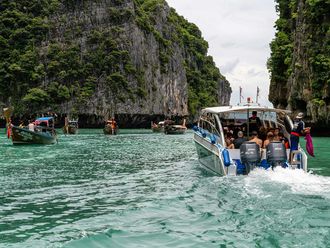You hear the Iguacu Falls long before you see them. On windless days, they announce themselves from about 15 miles away. At first, it's a dull rumble. But as you approach through the rainforest, this grows from rumbling thunder to an ear-splitting roar. Close up, it sounds like jet engines. Deafening.
Nothing can prepare you for the humbling power of Iguacu, without doubt one of nature's most impressive spectacles — though, shame on me, I had never heard of it before I travelled to Brazil. Little wonder I failed my O-level geography.
Vast curtains of water spread across nearly two miles of river, crashing down 275 falls, some 270 feet high. Clouds of spray rise like smoke 100 feet in the air. On moonlit nights, Iguacu throws up rainbows at midnight. These falls are so big one country can't contain them. Half are in Brazil, half in Argentina.
Celluloid connection
You might have seen them already without realising it. At the start of the film The Mission, a Jesuit priest is strapped to a wooden cross and set adrift on the River Iguacu, heading to his doom over the deepest of the Falls, the fearsome and aptly named Devil's Throat. As a test of conviction, the Indians force the priest, played by Robert de Niro, to climb the rock face, fighting against cascading torrents of water and razor-sharp rocks. Rather him than me. Even Niagara is dwarfed in comparison. I'm not surprised Eleanor Roosevelt gasped and declared, "poor little Niagara", when she saw Iguacu.
The Angel Falls in Venezuela are higher; Victoria Falls, on the Zambia-Zimbabwe border, boast a broader curtain of water; and the Kaieteur Falls, Guyana, have the single-most stupendous drop, at 741 feet. But stand before this raw and violent power and you are seeing one of the world's greatest natural phenomena.
I had flown here from Rio de Janeiro — dragged away from the delights of the Copacabana beach, where I had been visiting Helen Pinheiro, the inspiration for the Sixties' Bossa Nova hit Girl From Ipanema. A waterfall didn't seem to me to be much competition.
Power and beauty
Iguacu is a two-hour flight from Rio and the aircraft comes in low over the Itaipu Dam spanning the Parana River, which powers much of Paraguay's electricity needs and a large chunk of Brazil's.
On the drive through the verdant jungle of a national park, alive with jaguar, puma and ocelot, we passed through clouds of bright yellow Pieridae butterflies, the size of small birds.
It was on this drive to our hotel, the wonderful pink-washed Colonial-style Hotel das Cataratas managed by Orient Express — the only hotel inside the national park and with exclusive access to the Falls once the gates have closed — that I noticed something odd about my vision. Everything seemed suddenly clearer, brighter. The blues were bluer. The greens greener. It was like switching from an old television to high definition. What was happening?
Eder, our guide, explained: "It is the water in the air from the Falls, which literally washes the atmosphere and makes everything clearer than you have seen it before."
We lunched by the pool on heart of palm with octopus followed by local fish grilled with cashew fruits and asparagus before strolling to the Falls for a closer look.
It's the tame raccoons begging for food that capture your attention first. Then it's a winding path to a gangway that inches out more than 160 feet across the water and here they give you a red plastic mac to keep your clothes dry. Fat chance.
Nature's shower
It was like standing in a shower. I arrived the day after a series of tropical storms, when the river was swollen and the water falling at nine million litres a second.
One gust of wind and we were drenched — soaking wet through and hanging on to the handrail for dear life. Still, it was fun and accompanied by screams and howls of both terror and joy. But this was nothing. We were to shoot the rapids in a twin Mercury engine Zodiac assault craft right up to The Devil's Throat.
The helmsman took us only yards away from the cascading water. This is the closest I have ever felt to drowning.
It was here that I saw one of the most remarkable sights of my life. Flocks of swifts nest in the rocks behind the water, safe from predators. They have learnt how to fly in an out of the raging foam without injury. Incredible.
Tale of creation
According to Indian legend, the waterfall was created when a deity planned to marry a beautiful aborigine, who fled with her mortal lover in a canoe. In a rage, he sliced the river, creating Iguacu, condemning the lovers to fall for eternity.
Wilson Fernandez, the hotel botanist, took us on a more peaceful trip through the 185,000-hectare forest rich in fauna and trees. There are toco toucans, raccoons and curious monkeys.
Tramping through dense swamps and woods, Fernandez tells us that the wild animals are sometimes captured and ringed for monitoring.
Wildlife's addiction
He recounts the tale of an ocelot they found time after time in the same trap. "It was bewildering," Fernandez said, "until we realised the ocelot loved the sensation of being anaesthetised. The animal had become a kind of addict for the tranquillising drug."
We are a mile or two from the Falls so the river, though quite fast-flowing, isn't dangerous and we paddle about in canoes on its broadest reaches. I spot small alligators sunning on the muddy banks and keep the mother ship motor launch no more than an oar's length away. Still, this is a great Indiana Jones moment.
When football's World Cup arrives in Brazil in 2014 and the Olympic Games two years later, all the build-up will inevitably be about Rio, the Amazon and the country's wonderful beaches. But, I promise you, visitors will find nothing more spectacular than the Iguacu Falls.










